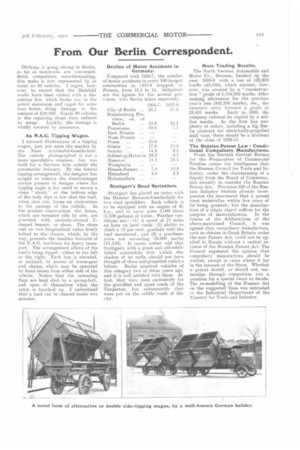From Our Berlin Correspondent.
Page 5

If you've noticed an error in this article please click here to report it so we can fix it.
Diirkopp is going strong in Berlin, as far as motoreahs are concerned. Brisk competition notwithstanding, this make is now represented by as many as 50 vehicles. I regret, however, to record that the Bielefeld works have been visited with a disestrous fire, which broke out in the petrol storeroom and raged for some four hours, doing damage to the amount of £20,000. Nearly 30 vehicles in the repairing shops were reduced to scrap. Luckily, the damage is wholly covered by insurance.
An N.A.G. Tipping Wagon.
I forward illustrations of a tipping wagon, just put upon the market by the Neue Automobil-Gesellschatt. The vehicle photographed is not a mere speculative creation, but was built for a German firm outside the automobile industry. By the lateral tipping arrangement, the designer has sought to remove the disadvantages always present in designs where the tipping angle is too small to secure a clean " shoot," or the bottom .edge of the body dips so low that the load, when shot out, forms an obstruction to the passage of the vehicle. In the present construction the boxes, which are mounted side by side, are provided with securely-riveted 1shaped bearers, or shoes, The shoes rest on two longitudinal tubes firmly bolted to the chassis, which, by the way, presents the familiar features of the N.A.G. machines for heavy transport. The arrangement allows of the load's being tipped—either to the left or the right. Each box is elevated, or inclined, by means of worm-gear and chains, which may he operated by hand levers from either side of the vehicle. Notice that the unloading flaps are kept shut by a spring-bolt, and open of themselves when the catch is knocked up. I understand that a load can be cleared inside two minutes. Decline of Motor Accidents in Germany.
Compared with 1906-7, the number
of motor accidents to every 100 freignt automobiles in 1907-8 dropped, ill Prussia, from 16.4 to 14. bubjoined are the figures for the several pro
inees, witn Berlin taken separately.
1906-7. 1007-8.
City of Berlin ... 24.1 21.3 Brandenburg Province, ex. of Berlin 16.1 Pomerania 7.7 15.8 50.0 East Prussia West Prussia Posen ...
lesia Saxony ... Schleswig-Holstein Hanover Westphalia Hessen-Nassau ... Rhineland Ff oh en zoll ern ...
Stuttgart's Road Sprinklers.
Stuttgart has placed an 'order with the Daimler Motoren-Gesellschaft for two road sprinklers. Each vehicle is to be equipped with an engine of 33 h.p., and to carry some 5,000 litres (1,100 gallons) of water. Further conditions are :—(1) A speed of 10 miles an hour on level roads; (2) ability to climb a 12 per cent. gradient with the load mentioned ; and (3) a purchaseprice not exceeding 23,000 marks (C1,150). It seems rather odd that Stuttgart, with a great and old-established automobile firm within the shadow of its walls, should not have thought of these self-propelled vehicks before. Berlin acquired vehicles of this category two or three years ago, and it is well satisfied with them. At first, they were used exclusively far the gravelled and quiet roads of the Tiergarten, but subsequently they were put on the cobble roads of the city.
More Trading Results.
The North German Automobile and Motor Co., Bremen, finished up the year 1908-9 with a loss of 132,858 marks (t.6,643), which amount, however, was covered by a " reconstruction " profit of 1,104,002 marks. After making allowances for the previous year's loss (342,256 marks), etc., the directors carry forward a profit of
28,451 marks. Early in 1909, the company reduced its capital by a million marks. As the firm has now plenty of orders, including a big Berlin contract for electrically-propelled mail vans, there should be a dividend at the close of 1909-10.
The Russian Patent Law : Conditional Compulsory Manufactures.
From the German Central Bureau for the Preparation of Commercial Treaties comes the intelligence that the Russian Council for Trade and Industry, under the chairmanship of a deputy from the Board of Commerce, met recently. to consider the Russian Patent Act. Provision 198 of the Russian Industry Statute already incorporates the enactment that a patent must materialize within five years of its being granted ; but the manufacture of a single object suffices for the purpose of materialization. In the course of the deliberations of the above-mentioned Council, it was agreed that compulsory manufacture, such as obtains in Great Britain under the new Patent Act, could not he applied in 'Russia without a radical revision of the Russian Patent Act. The Council expaessed the opinion that compulsory manufacture should be waived, except in cases where it lay in the interest of the State. Whether a. patent should, or should not, materalize through compulsion was a question for a special court to decide. The re-modelling of the Russian Act on the suggested lines was entrusted 10 the Industrial Department of the Ministry for Trade and Industry.




















